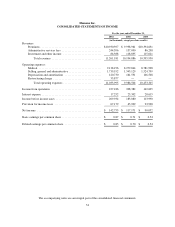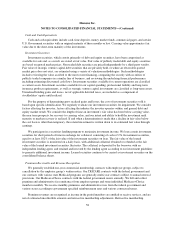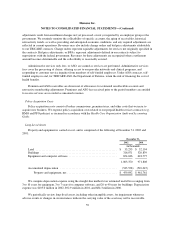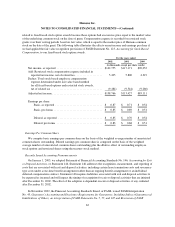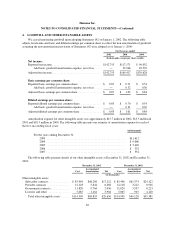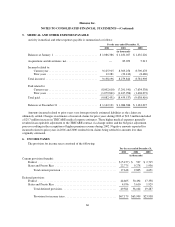Humana 2002 Annual Report Download - page 65
Download and view the complete annual report
Please find page 65 of the 2002 Humana annual report below. You can navigate through the pages in the report by either clicking on the pages listed below, or by using the keyword search tool below to find specific information within the annual report.
Humana Inc.
NOTES TO CONSOLIDATED FINANCIAL STATEMENTS—(Continued)
adjustments result from enrollment changes not yet processed, or not yet reported by an employer group or the
government. We routinely monitor the collectibility of specific accounts, the aging of receivables, historical
retroactivity trends, as well as prevailing and anticipated economic conditions, and any required adjustments are
reflected in current operations. Revenues may also include change orders and bid price adjustments attributable
to our TRICARE contracts. Change orders represent equitable adjustments for services not originally specified in
the contracts. Bid price adjustments, or BPAs, represent adjustments defined in our contracts subject to
negotiations with the federal government. Revenues for these adjustments are recognized when a settlement
amount becomes determinable and the collectibility is reasonably assured.
Administrative services only fees, or ASO, are earned as services are performed. Administrative services
fees cover the processing of claims, offering access to our provider networks and clinical programs, and
responding to customer service inquiries from members of self-funded employers. Under ASO contracts, self-
funded employers and, for TRICARE ASO, the Department of Defense, retain the risk of financing the cost of
health benefits.
Premium and ASO receivables are shown net of allowances for estimated uncollectible accounts and
retroactive membership adjustments. Premiums and ASO fees received prior to the period members are entitled
to receive services are recorded as unearned revenues.
Policy Acquisition Costs
Policy acquisition costs consist of broker commissions, premium taxes, and other costs that we incur to
acquire new business. We expense policy acquisition costs related to our prepaid health services contracts (e.g.
HMO and PPO policies) as incurred in accordance with the Health Care Organization Audit and Accounting
Guide.
Long-Lived Assets
Property and equipment is carried at cost, and is comprised of the following at December 31, 2002 and
2001:
December 31,
2002 2001
(in thousands)
Land ......................................................... $ 33,253 $ 32,194
Buildings ...................................................... 316,071 320,839
Equipment and computer software .................................. 654,046 618,775
1,003,370 971,808
Accumulated depreciation ........................................ (543,528) (510,047)
Property and equipment, net ................................... $ 459,842 $ 461,761
We compute depreciation expense using the straight-line method over estimated useful lives ranging from
3 to 10 years for equipment, 3 to 7 years for computer software, and 20 to 40 years for buildings. Depreciation
expense was $105.0 million in 2002, $92.9 million in 2001, and $84.3 million in 2000.
We periodically review long-lived assets, including other intangible assets, for impairment whenever
adverse events or changes in circumstances indicate the carrying value of the asset may not be recoverable.
59







